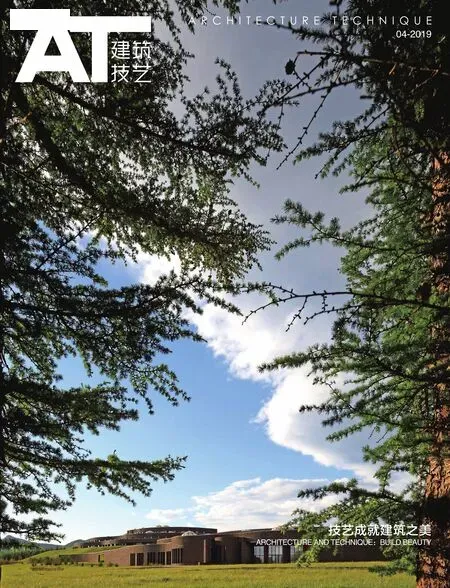公共参与语境下的新型图书馆建构
——访ALA Architects建筑事务所
采访 侯梦瑶
《建筑技艺》杂志社(AT)
AT:赫尔辛基Oodi中央图书馆坐落于赫尔辛基文化中心区域,场地附近有多个地标性建筑。中央图书馆作为新的文化地标,在设计之初是怎样确定其定位和价值,处理与周边建筑和场所的关系的?
Samuli Woolston:我们想要通过打造一个友好且美观的建筑,来展现类似这种图书馆机构的社会理想,图书馆三层(阅读空间)正好与议会大厦的入口处于同一高度,表达了一定的对话关系。
We wanted to reflect the social ideals of the library organization by creating a welcoming and beautiful building with its third main floor literally on level with the main entrance to the Parliament.
AT:建筑首先吸引人注意的是入口类似于桥梁的拱形空间,这个大型无柱空间提供了开阔的氛围,也呈现出一种欢迎的姿态,将城市广场的公共空间延伸到图书馆室内,同时也在室内形成了非常有活力的公共空间。这一创新的解决方案是怎样提出的?这个巨型结构在空间上还有什么作用?在设计和建造过程中是否遇到过困难?
Samuli Woolston:对于任何走近这座建筑的人,入口类似桥梁的拱形顶篷都在对其诉说着地面层空间的功能——聚集。这个巨型结构是通过跨度为100m的“桥梁”一般的钢结构来实现的,而且这个结构在以木质饰面包裹的二层空间里是完全可见的,也为二层空间营造了令人兴奋的阁楼般的氛围。从技术上讲,在这个钢结构“桥”上建一个全玻璃的透明空间并不容易。因为在暴风雨中,这个巨大的顶篷在其末端可能会有最多150mm的偏移,这意味着在这个结构之上的玻璃幕墙必须能够随屋顶结构的偏移而移动。最终,我们通过在屋檐结构内部设置的一个大型可灵活移动的结构节点解决了这个难题。
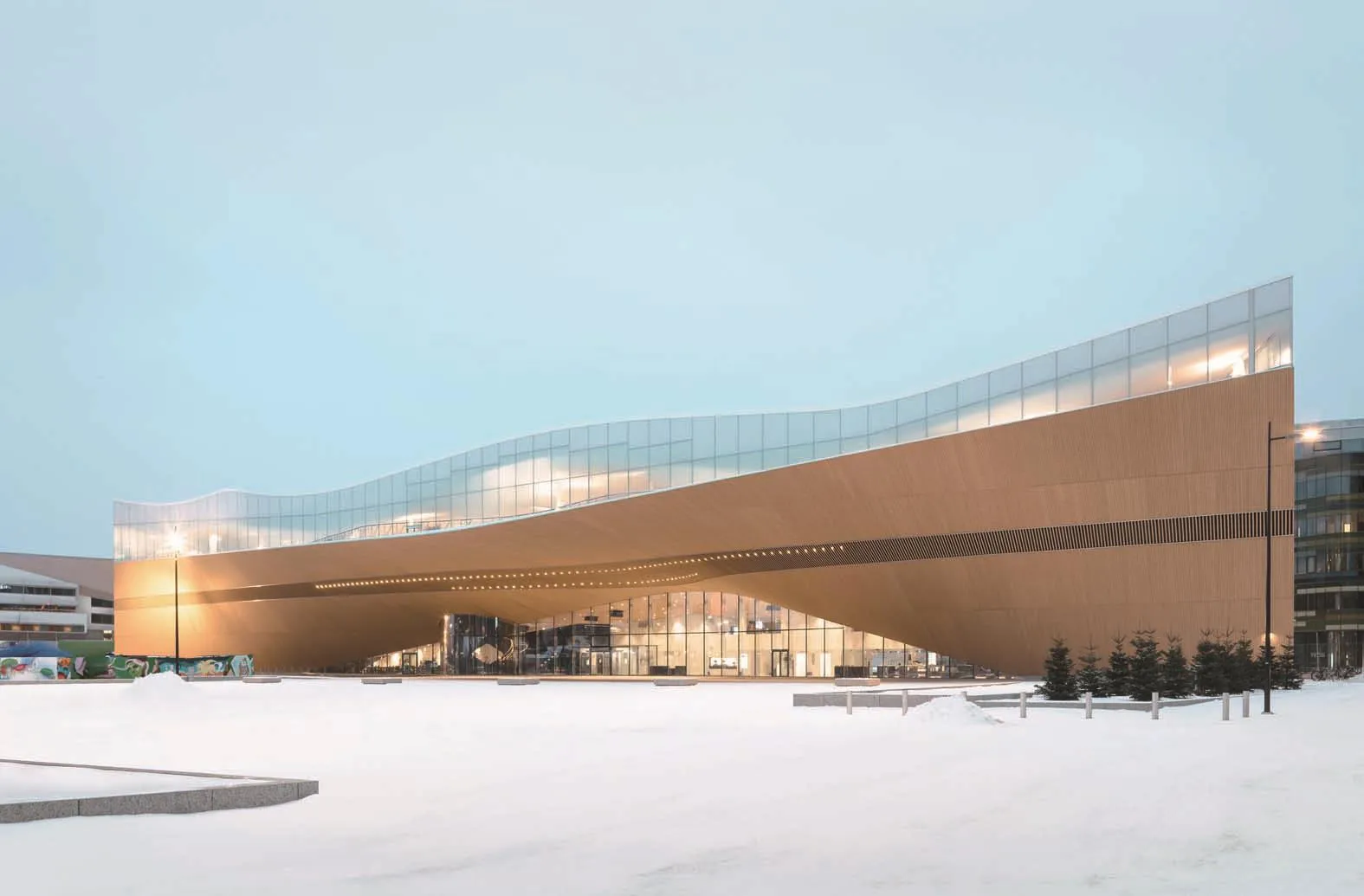
1 入口透视

2 入口处顶篷和室外空间

3 结构体系轴测图

4 首层轴测图
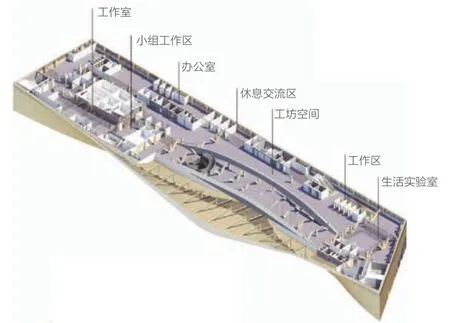
5 二层轴测图

6 三层轴测图
To anyone approaching the building, the vault and canopy describe the function of the ground floor: Gathering.This is achieved by a steel bridge structure with a span of about 100 meters. This structure is fully visible inside the wood clad enclosed second floor and gives this level an exciting attic-like atmosphere. Building a glass building on top of a bridge is not the most simple of tasks technically;the large canopy can deflect up to 150 mm at its tip in storm winds, which means the glass wall above it has to be allowed to move in relation to the roof structure. This was solved by a large flexible joint on the inside of the eaves structure.
AT:在与市民广场连接的入口上方,由墙面延伸扭转而形成的入口屋顶为建筑提供了大片可利用的室外公共空间,这个空间的设计希望给市民带来怎样的体验?开馆后,室外空间的使用是否达到了预期?
Samuli Woolston:入口处的室外公共空间区域的主要功能是提供遮蔽和举办大型活动。因此,入口屋顶内部有用于放置照明桁架和扬声器的托梁节点,以及更为干净整洁的电缆走线布置。在这个室外公共空间曾经有一个很大的舞台用来举行图书馆的开幕式,效果喜人,但是由于建筑是在赫尔辛基的隆冬时节开放的,所以这段时间并不适合在室外举办大型活动。我们期待着旁边的公园完工,也期待着春天的到来。
This area is meant for taking shelter and supporting big events. The ceiling contains joist points for lighting trusses and loudspeakers as well as clean routing for cables. There was a large stage there for the opening ceremonies, which worked very well, but as the building was opened in mid-winter, our weather doesn’t really support big spectacles outside. We’re looking forward to the park being finished and for the spring to arrive.
AT:建筑顶层(三层)的阅读空间是一片巨大的开放性景观,与建筑下部公共功能空间的活力和热闹不同,阅读空间主要是营造安静的阅读和思考氛围。因此,这部分体量的设计也采用了不同的空间和材料策略(比如白色、柔软的云顶屋面,巨大的单一空间只有极少量的柱子等),具体是如何实现的?
Samuli Woolston:我们希望顶层空间能够在向周围的城市无比开放的同时,也能远离下面街道的喧嚣。因此,我们将这层空间的四个角落都向上抬升,形成一个个小“山丘”的氛围,让人们能够自然地平静下来。这些小山丘也为顶层阅读空间带来了一种在类似空间中很容易缺失的亲密感,同时空间内现存的黑橄榄树(拉丁语学名:Bucida Buceras)更强调了这种平静。柔软的天花板由数个类似穹顶的形状组成,在没有额外制造功能性障碍的同时打破了空间的体量。天花板的吸音羊毛被粉刷了一层薄薄的石膏,用以打造安静的室内空间。窗户上印有随机渐变的圆点图案,以减少眩光和太阳辐射,这些渐变的圆点图案在面向议会大厦和芬兰大厦(Finlandia Hall,由著名建筑大师阿尔瓦·阿尔托设计)方向的窗户上消散开来,而在面向附近办公楼方向的窗户上则又逐渐密集起来1。
We wanted to make the top floor very open to the surrounding city, but lifted off of the bustle of the streetscape below. Lifting each end of this level up into small “hills” makes people naturally calm down. These hills also give the space an intimacy it would otherwise easily lack. The living Black Olive trees (lat. Bucida buceras) emphasize this calmness. The soft ceiling consists of several dome-like shapes, also breaking up the size of the space without creating functional obstacles. The ceiling of acoustic wool rendered with a thin layer of gypsum keeps the space quiet. The windows have a randomized gradient print which cuts glare and solar heat. This print lifts up to reveal the Parliament and Finlandia Hall and densifies towards the neighbouring office building.
AT:中央图书馆也因地制宜地选用了厚重的芬兰云杉木板作为建筑的主要饰面材料,在ALA Architects的其他项目中也经常出现这种木材的使用。这种材料策略除了基于气候条件考量,是否还有其他方面的考虑?其用于大型公共建筑设计希望建筑体现出什么性格?
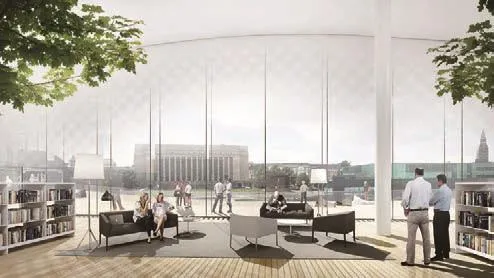
7 顶层窗户渐变圆点图案效果图
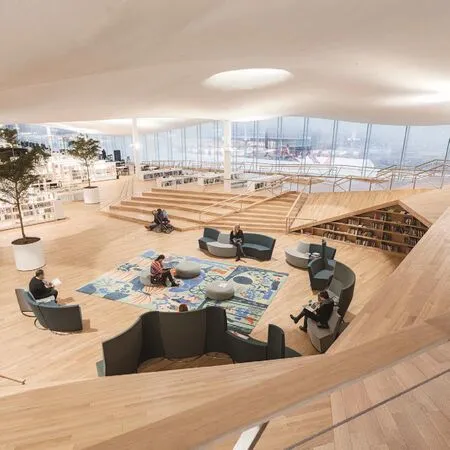
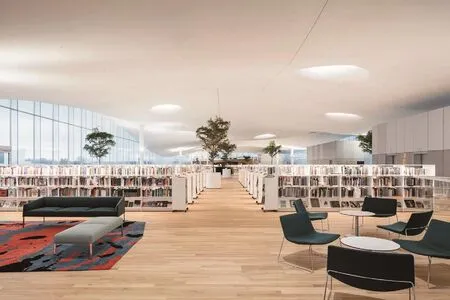
8,9 顶层阅读空间的“山丘”氛围

10 木材饰面

11 二层访客工作区域的温暖照明
Samuli Woolston:周围的建筑大多使用金属、石头和玻璃作为主要的立面材料,表达出一种非常坚硬的质感。但是我们希望能为这座图书馆建筑带来柔和感以及似曾相识的感觉,所以使用了大型云杉木板作为建筑的主要饰面材料。要知道,木材是芬兰建筑中最常见的建筑材料,森林是我们芬兰人身份认同的重要组成部分。
The surrounding buildings are all quite hard, using mainly metal, stone and glass in their facades. We wanted to bring softness and a certain familiarity to the building,as wood is the most common building material in Finnish houses. Forests are a big part of our identity.
AT:芬兰是非常注重可持续发展的国家,中央图书馆在可持续设计方面采取了哪些创新的解决措施?
Samuli Woolston:我们计算了每一种材料和产品的碳排放量,并将其控制在芬兰国家分类标准的最佳范围内。另外,在可持续方面,这座建筑的供暖和制冷系统是一个区域系统,这个系统已经覆盖了赫尔辛基市中心的大部分地区,并且范围还在不断扩大2。
The carbon footprint of every material and product was calculated and kept within our best national classification standards. One perhaps internationally interesting technological fact is that the building is heated and cooled by a district system already covering a large part of central Helsinki and expanding continuously.
AT:图书馆还运用了哪些创新的技术手段,用以提高人们的空间体验?
Samuli Woolston:经过精心设计的照明系统可以支持建筑空间中的每个功能。建筑顶层主要是间接照明,在色温和意境上都更接近于自然光;而二层的照明则在不同功能的空间中情况各不相同,以较为温暖的光线为主。
The lighting systems are carefully designed to support each function. The top floor has mainly indirect general lighting closer to natural daylight in colour temperature and mood, whereas the mid floor has a variety of conditions, mainly with warmer light.
AT:这座图书馆用于存书的空间只占1/3,而其他空间主要用于面向大众的公共活动和交往,使得图书馆更加注重公共参与而不仅是提供阅读空间。是否可以认为与其说是设计了一座图书馆,ALA Architects更像是打造了一座融合了不同文化、艺术、创新等功能设施的开放的城市中心?你们对现代图书馆如何定义?
Samuli Woolston:是的,这座图书馆确实更像是一个全面的社区建构,而不仅仅是一个藏书库。这种设计趋势在芬兰已经持续了好几年。我们认为图书馆这样的机构除了具有教育作用之外,还有更广泛的使命,即为人们能够在当代全球化、多元化的世界中更好地生存提供支持。这种开放和包容的社会态度也是建筑师应该在建筑设计中有所转译和表达的,让人们能够阅读建筑是很重要的。
Yes, this certainly is more of a general community building than a repository. This trend has been strong in Finland already for quite a few years. The library organization has a wider mission beyond direct education to support people to survive better in the contemporary global, multicultural world. This open and welcoming social attitude is also what architects should translate into their buildings. It is important that people can read buildings.
AT:最后,你们认为这座图书馆的什么特质使得ALA Architects赢得了这次国际竞赛?
Samuli Woolston:我认为ALA Architects之所以赢得这次国际竞赛,是因为我们的设计方案以一种易于理解且优美的方式,诠释了图书馆设计任务书中的功能性需求和象征性理想。
We believe our design interpreted the functional and symbolic ideals described in the competition programme in an understandable and beautiful way.
注释
1 关于窗户上的随机渐变图案:建筑顶层的窗户上随机放置了白色的圆点(其中一层在外玻璃窗上,另一层在内玻璃窗上),以减少夏季顶层的眩光和过热问题。规则的点阵图案会产生摩尔现象(在有一定间隔的物体上发生干涉条纹),所以我们决定用完全随机的图案排列以解决这个问题。窗户上部的圆点非常密集,往下渐变稀疏,就像雪花从天上轻轻落下,飘散在建筑周围。从远处看,窗户的顶部几乎是纯白的,模糊了窗户与屋顶之间的界线,而窗户下部则几乎是全透明的。在面向议会大厦和芬兰大厦一侧的窗户上,渐变圆点图案没有那么密集,因此具有更开放的视野。
2 关于建筑的供暖及制冷系统:这套系统是使用周边区域联合热电厂的余热供应热能和热水,过剩的能源也用于基于水库的冷却系统;只有在冬季才使用额外的供暖设备。因此该系统是非常节能的。

